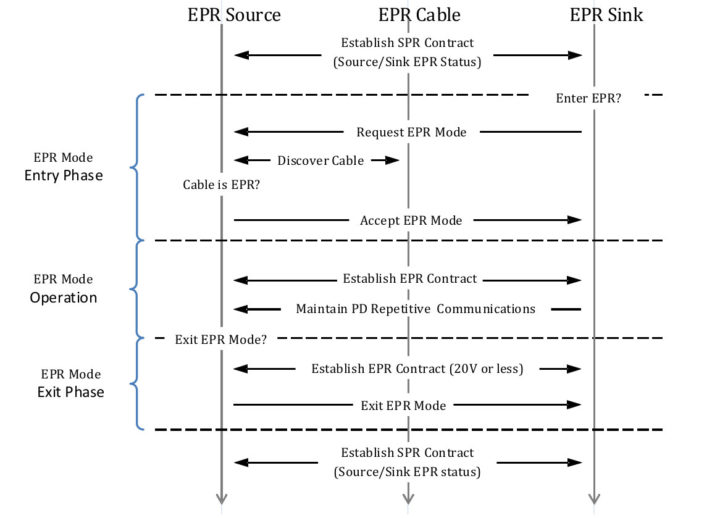Many devices have switched from a Micro USB port or a power barrel jack to the USB-C port in recent years, as the latter allows for higher currents, and up to 100W power input in USB PD (Power Delivery) compliant systems.
While 100W will be more than enough for most devices, more power-hungry devices or systems still need a power brick, for example, gaming laptops and mobile workstations. But the USB Type-C specification 2.1 aims to change that by upping the maximum power to 240W.
As noted by Benson Leung in a Reddit Thread the part of the specification that handles the 240W power is the EPR (“Extended Power Range”) that defines requirements for cables, chargers, and devices:
3.11 Extended Power Range (EPR) Cables
3.11.1 Electrical Requirements
Extended Power Range cables have additional requirements to assure that these cables can deliver the full defined voltage and current range for USB PD EPR operation. EPR cables shall functionally support a reported 50 V and 5 A o peration. The minimum functional voltage that a cable shall support is 53.65 V. The electrical components potentially in the path of V BUS in an EPR cable, e.g. bypass capacitors, should be minimally rated for 63 V.To control the impact of inductive kickback and ringing that can increase the chance of arcing between a USB Type-C plug and receptacle when a cable is removed while power is still applied, an EPR cable may include a snubber capacitor within the plug at ea ch end of the cable. See Appendix H for more information.
3.11.2 EPR Cable Identification Requirements
All EPR cables shall be Electronically Marked and include EPR-specific information in the eMarker as defined by the USB PD specification. As defined in the USB PD specification, EPR cables are marked as 50 V and 5 A capable. All EPR cables shall be visibly identified with EPR cable identification icons as defined by the USB-IF. This is required so that end users will be able to confirm visually that the cable supports up to as high of PDP = 240W as defined in the USB PD specification.

240W can be delivered using 48V up to 5A. You’ll find the full details both in the latest USB Type-C 2.1 and USB PD 3.1 specifications that can be found on usb.org here and there.
Via Liliputing

Jean-Luc started CNX Software in 2010 as a part-time endeavor, before quitting his job as a software engineering manager, and starting to write daily news, and reviews full time later in 2011.
Support CNX Software! Donate via cryptocurrencies, become a Patron on Patreon, or purchase goods on Amazon or Aliexpress. We also use affiliate links in articles to earn commissions if you make a purchase after clicking on those links.




What is the use case for this? When is it a better solution to use a special USB-C power supply with a special USB-C cable rather than just a regular power brick?
Cross compatibility between OEMs.
I have a container box full of chargers collected over the decades, that is still working but no device to use it on.
As real world example:
In example above manufacturer have to have 2 different power adapter cables. With this new one it can make them same as in the past.
Without enforcement of TM and standards, this another mess of subpar product waiting to be release.
@Jean, this is unrelated and I’m commenting here because comments are disabled on sponsored posts on your website.
Should you be allowing posts like https://www.cnx-software.com/2021/05/27/how-to-get-windows-10-cheaply-legally-at-6-84-per-pc?
They’re notorious for selling keys to users that Microsoft disables later on because they’re actually pirated. These websites are operated from a certain country where accountability does not exist (in many cases hosted elsewhere, but you know who runs them and from where).
Most of those companies are registered in Hong Kong.
I was wary at the beginning too, but I can see those have been running for years without any DMCA request from Microsoft lawyers.
While a post like that: https://www.cnx-software.com/2012/03/02/how-to-install-windows-8-in-linux-with-qemu/ showing how to install a beta version of Windows 8 in Linux with QEMU was quickly banned from search results following a DMCA takedown request, which I have not been able to remove since then.
The thing with those OEM keys is that they are tied to the hardware, so can’t be transferred to another machine, and may not work after wiping out the machine, and reinstalling everything from scratch.
all power over ethernet 48vdc show a 70-85% effiency to 1.8-3.3-5vdc, in addition of power loss from common ac supply 19v. it’s not a big deal for small 10w usb power device.
AC to 19v -> buck to charge li-ion battery -> step up to 50v -> buck to 5vdc sorry 40% energy loss
The first USB-C cables supporting 240W charging are now available.
For example: https://www.club-3d.com/en/detail/2600/